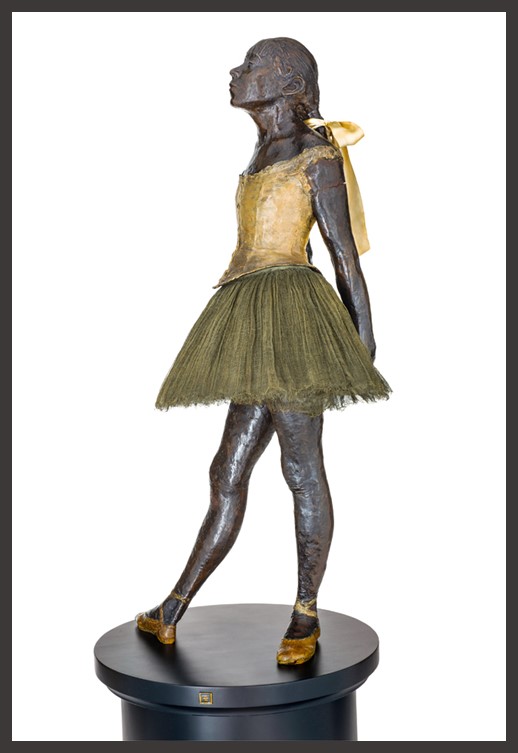
Little Dancer Aged Fourteen, circa 1878-1881, Bronze with brown patina, tulle skirt and satin ribbon on wooden base, Cast by A. A. Hébrard, Paris, circa 1922, 96.5×47×35 cm, Basil and Elise Goulandris Foundation, Athens, Greece
https://goulandris.gr/en/artwork/degas-edgar-little-dancer-aged-fourteen
You may write me down in history / With your bitter, twisted lies, / or may trod me in the very dirt / But still, like dust, I’ll rise. / Does my sassiness upset you? / Why are you beset with gloom? / ‘Cause I walk like I’ve got oil wells / Pumping in my living room. / Just like moons and like suns, / With the certainty of tides, / Just like hopes springing high, / Still I’ll rise. / Did you want to see me broken? / Bowed head /and lowered eyes? / Shoulders falling down like teardrops. / Weakened by my soulful cries. / Does my haughtiness offend you? / Don’t you take it awful hard / ‘Cause I laugh like I’ve got gold mines / Diggin’ in my own back yard. / You may shoot me with your words, / You may cut me with your eyes, / You may kill me with your hatefulness, / But still, like air, I’ll rise. / Does my sexiness upset you? / Does it come as a surprise / That I dance like I’ve got diamonds / At the meeting of my thighs? / Out of the huts of history’s shame / I rise / Up from a past that’s rooted in pain / I rise / I’m a black ocean, leaping and wide, / Welling and swelling I bear in the tide. / Leaving behind nights of terror and fear / I rise / Into a daybreak that’s wondrously clear / I rise / Bringing the gifts that my ancestors gave, / I am the dream and the hope of the slave. / I rise / I rise / I rise… writes Maya Angelou and I think of the Little Dancer Aged Fourteen by Edgar Degas in the Basil and Elise Goulandris Foundation in Athens… https://www.poetrysoup.com/famous/poems/best/dance
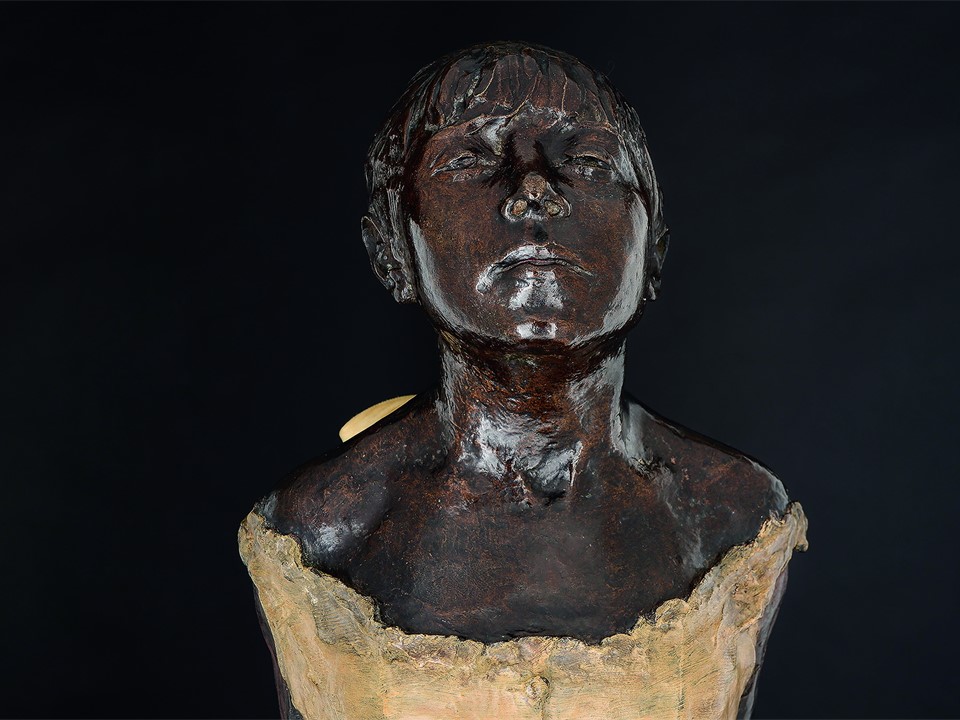
Little Dancer Aged Fourteen (detail), circa 1878-1881, Bronze with brown patina, tulle skirt and satin ribbon on wooden base, Cast by A. A. Hébrard, Paris, circa 1922, 96.5×47×35 cm, Basil and Elise Goulandris Foundation, Athens, Greece
https://goulandris.gr/en/shop/category/edgar-degas
Edgar Degas found ballet dancing irresistible and at the Paris Opéra, he frequently attended grand ballet productions on stage and small ballet classes in rehearsal studios. He was an astute observer of the ballerinas’ daily routine of rehearsing, stretching, and resting. He studied dance movements and filled numerous notebooks with sketches to help him remember details so he could later compose paintings and model sculptures in his studio. His penetrating observations are best exemplified in the artist’s statue of the Little Dancer Aged Fourteen exhibited in the Basil and Elise Goulandris Foundation in Athens. The Little Dancer’s name was Marie van Goethem… and she was a young student at the Paris Opéra Ballet School. https://www.nga.gov/content/dam/ngaweb/Education/learning-resources/an-eye-for-art/AnEyeforArt-EdgarDegas.pdf and https://goulandris.gr/en/artwork/degas-edgar-little-dancer-aged-fourteen
Adolescent Marie, according to Basil and Elise Goulandris Foundation experts, is presented standing in a dynamic but relaxed way, her feet in the “fourth position,” her hands held behind her back, the head slightly raised, and the entire appearance revealing all the ambiguity of an adolescent figure deformed by the dancing practice. The thinness of her body, the possible malnutrition suggested by a slightly swollen belly, does not diminish the girl’s sensuality, whose proud position, almost with an air of defiance, may seem, according to observers, dignified, provocative, or despising… I rise / Into a daybreak that’s wondrously clear / I rise… https://goulandris.gr/en/artwork/degas-edgar-little-dancer-aged-fourteen
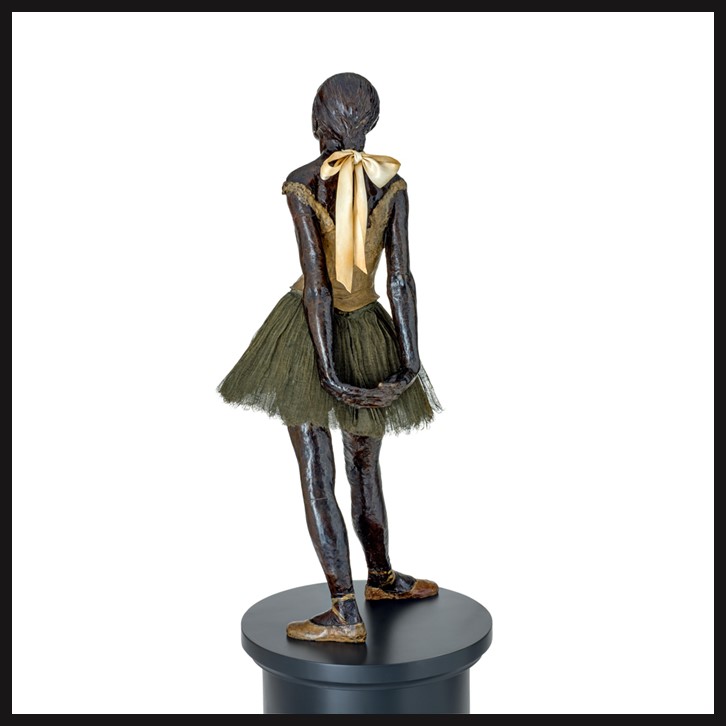
Little Dancer Aged Fourteen (back view), circa 1878-1881, Bronze with brown patina, tulle skirt and satin ribbon on wooden base, Cast by A. A. Hébrard, Paris, circa 1922, 96.5×47×35 cm, Basil and Elise Goulandris Foundation, Athens, Greece
https://goulandris.gr/en/artwork/degas-edgar-little-dancer-aged-fourteen
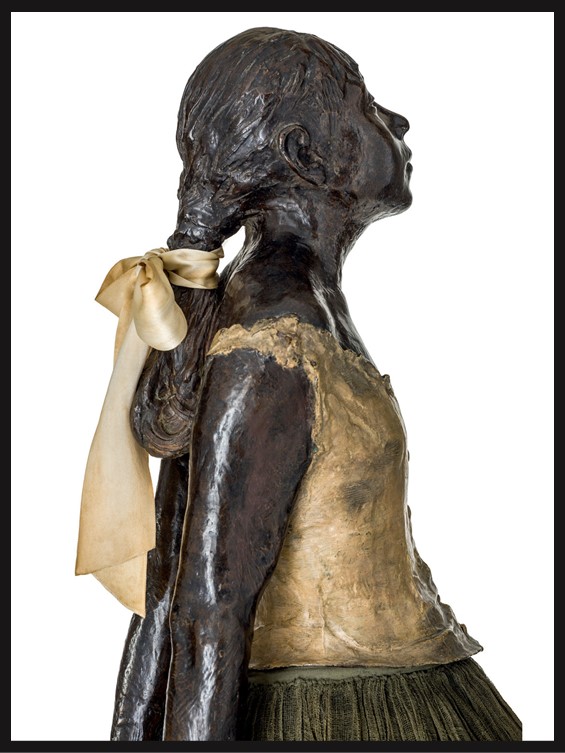
Little Dancer Aged Fourteen (side view), circa 1878-1881, Bronze with brown patina, tulle skirt and satin ribbon on wooden base, Cast by A. A. Hébrard, Paris, circa 1922, 96.5×47×35 cm, Basil and Elise Goulandris Foundation, Athens, Greece
https://goulandris.gr/en/artwork/degas-edgar-little-dancer-aged-fourteen
Degas worked on Little Dancer Aged Fourteen for more than two years. He first created an armature of metal, wood, wire, rope, and two long paintbrushes for the dancer’s shoulders. Then, he modeled the figure first with clay to define the muscles, and then he modeled the final layer of the sculpture in wax. It was not enough… He dressed the statue in real ballet satin slippers, a linen bodice, a muslin tutu, and a wig of human hair, braided and tied with a ribbon. Finally, to complete the illusion, a coat of wax spread smoothly with a spatula over the surface of the sculpture, giving it an overall waxy, lifelike look. After Degas died in 1917, copies of this wax figure were cast in plaster and bronze, and Little Dancer Aged Fourteen grew in fame around the world. https://www.nga.gov/content/dam/ngaweb/Education/learning-resources/an-eye-for-art/AnEyeforArt-EdgarDegas.pdf
For a Student Activity, please… Check HERE!
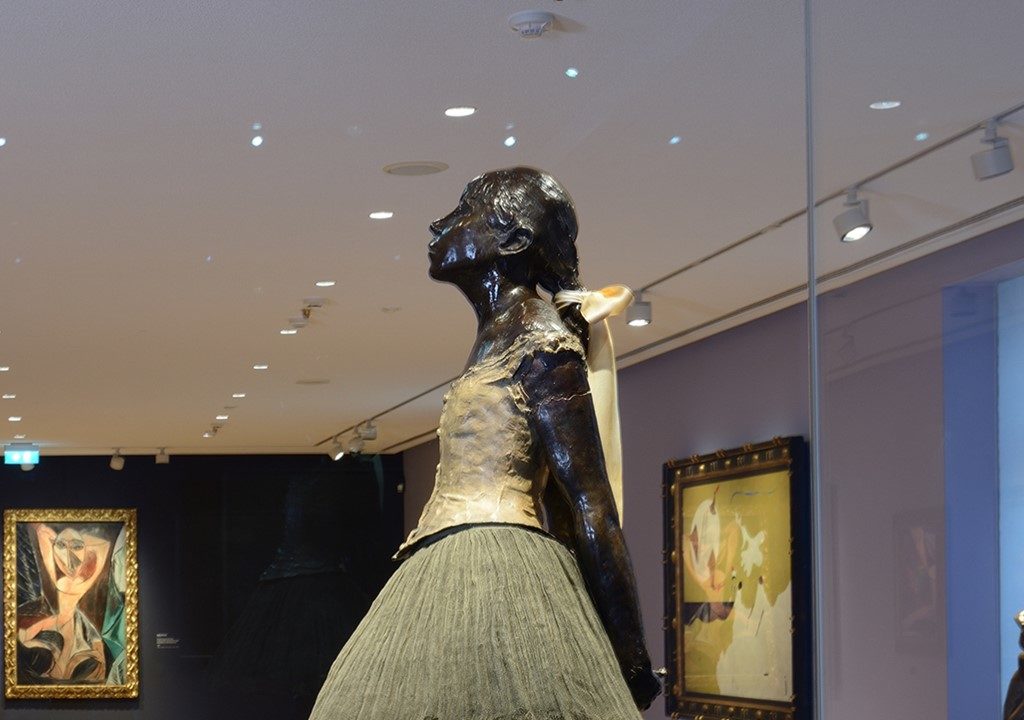
Little Dancer Aged Fourteen (Museum Hall view), circa 1878-1881, Bronze with brown patina, tulle skirt and satin ribbon on wooden base, Cast by A. A. Hébrard, Paris, circa 1922, 96.5×47×35 cm, Basil and Elise Goulandris Foundation, Athens, Greece
https://goulandris.gr/en/visit/be-athens